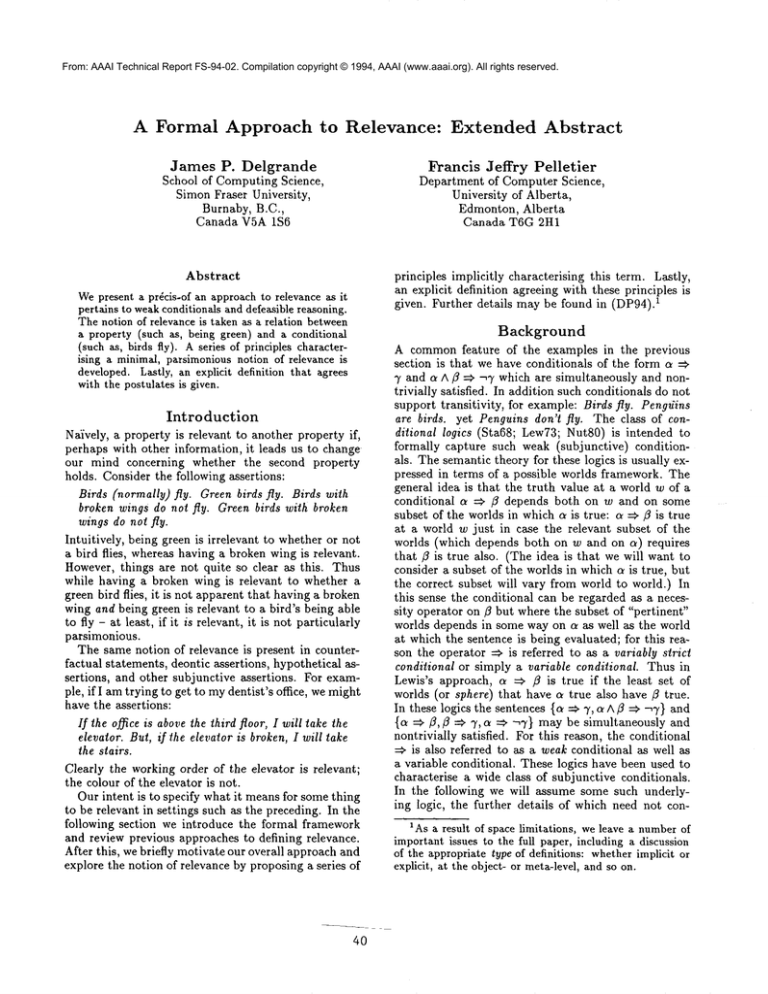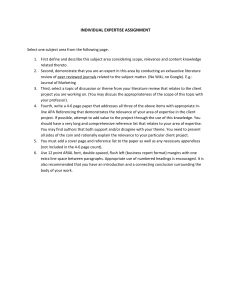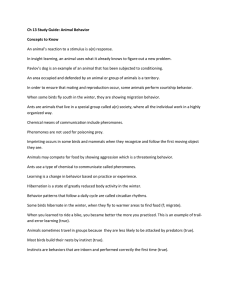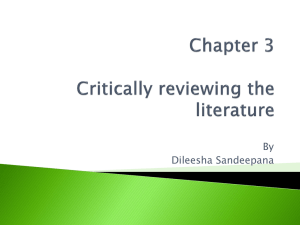
From: AAAI Technical Report FS-94-02. Compilation copyright © 1994, AAAI (www.aaai.org). All rights reserved.
A Formal Approach to Relevance:
James P. Delgrande
School of Computing Science,
Simon Fraser University,
Burnaby, B.C.,
Canada V5A 1S6
Extended
Abstract
Francis Jeffry Pelletier
Department of Computer Science,
University of Alberta,
Edmonton, Alberta
Canada T6G 2H1
Abstract
Wepresent a precis-of an approach to relevance as it
pertains to weakconditionMsand defeasible reasoning.
The notion of relevance is taken as a relation between
a property (such as, being green) and a conditional
(such as, birds fly). A series of principles characterising a minimal, parsimoniousnotion of relevance is
developed. Lastly, an explicit definition that agrees
with the postulates is given.
Introduction
Naively, a property is relevant to another property if,
perhaps with other information, it leads us to change
our mind concerning whether the second property
holds. Consider the following assertions:
Birds (normally)fly. Green birds fly. Birds with
broken wings do not fly. Green birds with broken
wings do not fly.
Intuitively, being green is irrelevant to whether or not
a bird flies, whereas having a broken wing is relevant.
However, things are not quite so clear as this. Thus
while having a broken wing is relevant to whether a
green bird flies, it is not apparent that having a broken
wing and being green is relevant to a bird’s being able
to fly - at least, if it is relevant, it is not particularly
parsimonious.
The same notion of relevance is present in counterfactual statements, deontic assertions, hypothetical assertions, and other subjunctive assertions. For example, ifI amtrying to get to mydentist’s office, we might
have the assertions:
If the office is abovethe third floor, I will take the
elevator. But, if the elevator is broken, I will take
the stairs.
Clearly the working order of the elevator is relevant;
the colour of the elevator is not.
Our intent is to specify what it means for something
to be relevant in settings such as the preceding. In the
following section we introduce the formal framework
and review previous approaches to defining relevance.
After this, we briefly motivate our overall approach and
explore the notion of relevance by proposing a series of
4O
principles implicitly characterising this term. Lastly,
an explicit definition agreeing with these principles is
1given. Further details may be found in (DP94).
Background
A commonfeature of the examples in the previous
section is that we have conditionals of the form ~ =¢,
7 and a A fl =¢~ -~7 which are simultaneously and nontrivially satisfied. In addition such conditionals do not
support transitivity,
for example: Birds fly. PengUins
are birds, yet Penguins don’t fly. The class of conditional logics (Sta68; Lew73; Nut80) is intended
formally capture such weak (subjunctive) conditionals. The semantic theory for these logics is usually expressed in terms of a possible worlds framework. The
general idea is that the truth value at a world w of a
conditional a =¢, fl depends both on w and on some
subset of the worlds in which a is true: (~ =¢, fl is true
at a world w just in case the relevant subset of the
worlds (which depends both on w and on or) requires
that/3 is true also. (The idea is that we will want to
consider a subset of the worlds in which a is true, but
the correct subset will vary from world to world.) In
this sense the conditional can be regarded as a necessity operator on f~ but where the subset of "pertinent"
worlds depends in some way on ~ as well as the world
at which the sentence is being evaluated; for this reason the operator =¢, is referred to as a variably strict
conditional or simply a variable conditional. Thus in
Lewis’s approach, (~ => fl is true if the least set of
worlds (or sphere) that have c~ true also have/3 true.
In these logics the sentences {(~ ::~ 7, c~ A fl =~-~7) and
{c~ ::~ fl, fl ~ 7, a :=> "~7} maybe simultaneously and
nontrivially satisfied. For this reason, the conditional
:2z is also referred to as a weak conditional as well as
a variable conditional. These logics have been used to
characterise a wide class of subjunctive conditionals.
In the following we will assume some such underlying logic, the further details of which need not con1Asa result of space limitations, we leave a numberof
important issues to the full paper, including a discussion
of the appropriate type of definitions: whether implicit or
explicit, at the object- or meta-level, and so on.
This seems to work relatively well. Consider a default theory where birds fly; shorebirds fly; AustrMian
birds do not fly; Australian shorebirds fly; and Australian shorebirds with broken wings do not fly. Hence:
cern us here (but see (DP94)). The connective ==~
represent a weakconditional, corresponding to Lewis’s
"would" conditional (wherein a conditional cannot be
vacuously true); D will be used for standard material
implication.
B ~ F, ShB ~ F, AuB ~ ",F, AuB A ShB
F, AuB A ShB A BW ~ "-,F.
In addition suppose Australian birds and shorebirds
must be birds, so O(AuB D B) and D(ShB D B). We
obtain:
ShB is not relevant to B ::# F.
ShB is relevant to
AuB ~ --,F.
ShB is not relevant to B A BW::¢, ~F.
This notion of relevance seems to be heading in the
right direction. However, according to the tentative
definition, if something is relevant to a conditional,
then so is that thing conjoined with any other property, and we find this objectionable because we want
to know exactly what brought about the relevance. We
want a notion of "minimal relevance", and so we reject
the following "augmentation" principle:
Related Work (SG87) explicitly
addresses the
problem of irrelevance in problem-solving systems
(SG87). There the idea is to explicate the notion
a fact f being irrelevant to fact g given a knowledge
base M. In the full paper we argue that these notions
are syntactic, depending on the form of sentences. This
is inappropriate to the task at hand because it means a
sentence could be relevant to something, but a logically
equivalent one not; and that a sentence could be relevant to something but not relevant to a logically equivalent wayof stating it. Moreclosely-related approaches
are given in (GKr78) and (DP93). Ggrdenfors specifies
what it means for a property p to be relevant to r on
evidence e (and with respect to some background theory). Darwiche and Pearl describe what it means for
a database A to find X (logically) independent_of Y,
given Z. Space limitations preclude a lengthy discussion, but we note that neither approach is appropriate
here: G~rdenfors deals with a probabilistic interpretation of relevance, and Darwiche/Pearl deal with a
restricted interpretation in classical databases. In contrast, we are concerned with a general specification of
this notion, in the class of conditional logics.
Lastly, the relevance logics of (AB75) and subsequent researchers, deal with a notion with (arguably)
the restricted interpretation "deductively-relevant-to".
Initial
Considerations
There are at least two distinct senses of the term relevant. First, relevance may be taken as a relation
between properties. For example, we might say that
being feathered is relevant to birdness. This sense is
treated, for example, in (Goo72). Following Goodman,
we call this sense of relevant ’about’ (and so might
assert for example that Vancouver is about British
Columbia). Howeveras we show in the full paper, this
notion is inappropriate here.
Second, relevant maybe taken as a relationship between a property and a proposition represented by a
conditional; this is the sense that we adopt. Thus,
raather than saying that albinoism is relevant to being black, we say that albinoism is relevant to ravens
being black. So the goal is to specify conditions for a
property ~ being relevant to fl =~ 7Intuitively, a is relevant to a conditionalfl ==:, 7 if the
addition of a changes our belief (confidence, whatever)
in 7. Wehave the following tentative definition:
Definition 1 a is relevant to fl ::~ 7 iff:
7- ~ fl ==~ 7 and 7- ~ a A l3 ==~-"7,
T ~ fl ::~ -~7 and Y ~ a h fl ::~ 7.
or
/41
AUG:
If a is relevant to fl ::~ 7 then c~ A/~ is relevant
tofl~7.
This wouldnot be a reasonable relation, since it makes
too manythings relevant. For example, if all we know
is that birds normally fly, but birds with broken wings
do not, then it seems that the only thing relevant to
birds flying is having a broken wing. Having a broken
wing and being green is not relevant; nor is having
a broken wing together with the current state of the
Tokyo stock market. There are two reasons why such
assertions are not relevant. First, if we were making
a default inference concerning whether a bird flies or
not, we would want to consider only whether it had a
broken wing or not; we clearly would not want to also
consider the Tokyostock market. Second, intuitively, a
relevant condition should itself be parsimonious in that
2it ought not contain as part an irrelevant condition.
Principles
of Relevance
This section proposes a number of principles governing relevance with respect to weakconditionals. First,
relevant and irrelevant are taken as complementarynotions:
Definition 2 c~ is relevant to (fl ::~ 7) iff c~ is not
irrelevant to (fl ~ 7).
Relevance in the sense under discussion is clearly
a semantic notion, so no formalisation of relevance
should depend on syntactic form:
2Thisis precisely the stance taken in diagnostic reasoning, where one is interested in a minimaldiagnosis. Thus
having influenza could be an adequate diagnosis accounting
for fever, muscularpain, etc. Howeverhaving influenza and
a lawn that needscutting, while equally well accountingfor
the symptoms,wouldnot constitute an adequate diagnosis.
As we discuss below, Definition 1 leads to contentious results, in that strengthenings or weakenings of relevant conditions are not reasonably handled.
However, we want to admit some strengthenings and
weakeningsof relevant conditions, and it is to this issue that we now turn. Consider strengthenings first;
according to Definition 1, we would have that:
PI: If a is relevant to fl ==~ 7 and
T ~ a =_ 6 and T ~ fl
- r I and ’/-~7-~
then 6 is relevant to r/==~(.
The conditional logics we are considering allow substitutivity under equivalents with respect to ==~ in the
antecedent of a conditional, and so we could replace
principle P1 with the stronger version.
Pla: If ~ is relevant to (fl =~ 7) and T ~ (a
6) and T~(fl4:~rl)
and T~(7_=~)
then 6 is relevant to 17 =~ ~.
On the other hand, no weakening of the antecedent
of a conditional should be relevant:
P2: If T ~ fl D a then a is not relevant to fl :=~ 7If T is a designated propositional sentence true in
all models, then if we take a as T in P2, we obtain the
result that:
T is not relevant to fl =~ 7-
(1)
If ~ and fl are mutually contradictory,
nothing to say about whether fl ==~ 7:
then a has
ShB A BWis not relevant
(5)
BWA Gr is relevant to B ::~ F.
(6)
Thus, in the first case, being a shorebird with a broken
wing is not relevant to Australian birds flying, since
Australian birds don’t fly, nor do Australian shorebirds
with broken wings. However, if we consider the individual conjuncts ShB and BW, we see that:
ShB is relevant
to AuB ~ ~F and BW is
relevant to AuB A ShB ~ F.
Arguably then ShB A BW should be relevant to
AuB ~ -"F since, given AuB along with ShB A BW,
we would want to conclude -~F by default, but for different reasons than if we were just given AuB alone.
Thus ShB A BW should be relevant to AuB ::~ ~F,
since ShB is. Weadd the condition:
P6: If a is relevant to fl ==~ 9’ and 6 is relevant to
c~ Afi :=~ 7 then c~ A 6 is relevant to fl ::~ 9’.
This means that ShB A BWis now relevant to AuB
-~F, and hence the problem with (5) is solved; but
we are still left with (6) above, the fact that having
a broken wing and being green is relevant to a bird
flying. Someone might wish to argue that BW A Gr
is relevant to B ::~ F, since clearly birds fly whereas
green birds with broken wings do not. However this
argument, relying on augmentation, seems to confuse
(6) with the assertion:
BW is relevant
to BAGr=t,F
This last assertion is clearly acceptable, since green
birds normally fly whereas green birds with broken
wings normally do not. Note that if we were to take
the position that BWA Gr is relevant to B ::t, F then
P6 could be replaced by an augmented variant, which
we have already rejected:
P6 ": If a is relevant to fl ::~ 7 then a A 5 is relevant
to fl =t, 9’.
For similar reasons we reject another variant of P6:
P6": If a is relevant to fl ::t, 7 and 5 is relevant to
fl =~ 7 then a A 6 is relevant to fi :~ 7.
For, if (~ and 6 are both relevant to fl =~ 9’ then it
must be that fl A c~ ::~ 7 and fl A 6 ::~ 9’ have the same
truth value in 7-.3 G~irdenfors(G~ir78) rejects a similar
principle, arguing that it leads to unintuitive results.
P3: If’/- ~ O-~(~Afl) then a is not relevant to fl ==~
Weobtain as corollaries of this principle that:
~fl is not relevant to fi =~ 7.
to AuB :=~ ~F
(2)
~T is not relevant to fl ==~3’.
(3)
Our criterion of parsimony leads to the next principle, which states that there are irrelevant properties:
P4" If~9’lV...V7~
then
for some k, where 1 <_ k < n, we have that 7k
is not relevant to fl =~ 7.
That is, if 71, ¯ ¯., 7~ essentially cover all possibilities,
then for any given conditional, some 7i is irrelevant.
For n -- 2 in P4 we obtain:
If 6 is relevant to fl =~ 7 then -~ is irrelevant to fl =~ 7.
(4)
Letting n = 1 in P4, also yields (1).
The next postulate is one which may or may not be
adopted, depending on one’s intuitions.
P5: If r~ is relevant to fl ==~ 7 then c¢ is relevant to
fl ~ -"7.
The following relation is appealing, but isn’t quite
right:
If 7- ~ a ::~ 7, 7- ~ fl ::~ -~7 and 7- ~ <>(a A fl)
then fl is relevant to a ::~ 3’ or a is relevant to
Thus, if ~ ::~ 7 and’fl ::~ -"7 are true in 7-, then given
a A fl we will either not conclude 7 by default or else
won’t conclude -~7 by default, The difficulty however
is that we don’t know whether the conclusion 7 or "7
is blocked; and this goes against our interpretation of
"relevant" is that of "provably relevant".
aAgainthis is the stance taken in diagnostic reasoning:
having influenza and having allergies might both account
the same set of symptoms;howeverhaving-influenza-andallergies wouldnot be a distinct diagnosis, but rather conflates two individual diagnoses.
42
Such concerns do not apply to weakenings of relevant
conditions. Consider for example where we have a theory in which birds fly and (as usual) birds with broken
wings do not fly, nor do Australian birds. If we learned
that a particular individual either had a broken wing,
or was from Australia, then we would nonetheless want
to conclude that it did not fly. Consequently we adopt
the following:
P7: If a is relevant to /3 =¢~ 7 and 6 is relevant to
13 =¢, 7 then a V 6 is relevant to/3 ~ 7Thus having a broken wing or being an Australian bird
is relevant to a bird’s flying.
An Explicit
Definition
of Relevance
In this section we present an explicit definition of relevance that satisfies (most of) the postulates of the preceding subsections. Webegin with Definition 1 which
supplies a base case, and from this define relevance.
A condition is relevant if it is naively relevant and not
composedof two "independent" relevant conditions, or
is formedby iterated notions of relevance:
Definition 3
a is naively relevant to ]3 ::~ 7 iff:
T ~ IJ ~7 and T ~ a A l3 :ez -~7, or
7" ~ /3 =¢, -~7 and T ~ a A /3 =~7,
Definition 4
a is relevant to ]3 =¢, 7 if and only if
I. for every 6 and 6’ where 77 ~ c~ =_ (6A6’) and
where 6 and 6~ are nai’vely relevant to fl =¢, 7 we
have 77 ~ c~ =_6 or 77 ~ c~ =_6’, or
2. there is cg such that (c~ A/3) D (c~’ A 13) wherec~
relevant to c~~ A ]3 :=~7 andc~t is relevant to fl ==~7.
The notion of relevance expressed in Definition 4, Part
2 ensures that we have a chain of successively stronger
propositions, each directly relevant to the next in the
"context" of/3. Thus, AuBis relevant to B :=¢, F, and
so AuB A ShB is relevant to B :=~ F even though both
B ==~ F and AuB A ShB A B =¢, F are true. Wealso
obtain the result:
Theoremi Definition
4 fulfills
P1 - PT.
Arguably our definition captures a reasonable notion
of relevant. For example, we obtain the following:
BW
BW A Gr
BW
BW
ShB A BW
BW V AuB
BW V Gr
is
is
is
is
is
is
is
relevant to
not relevant to
relevant to
not relevant to
relevant to
relevant to
not relevant to
B ::~ F
B =¢, F
B A Gr =v F
AuB ::~ -~F
AuB ::~ -~F
B ::~ F
B =:¢, F
Conclusion
Wehave presented an investigation of the notion of relevance with respect to weakor defensible conditionals.
The intent has been to characterise this notion with
respect to the class of "commonsense" or weak conditionals, as expressed within the general framework
of conditional logics (encompassing logics of counterfactuals, default properties, obligation, and other subjunctive conditionals). A series of principles characterising relevance was presented and from this an explicit
definition is given.
This approach may have some practical
consequences. Typically in conditional logic one does not
have modus ponens for the weak conditional. For example, given that birds normally fly, we cannot conclude that a particular individual flies. Yet the consequent of the conditional constitutes a plausible default
conclusion. Hence, all other things being equal, a bird
may (pragmatically)
be concluded to fly. What the
present work may allow is a means of sanctioning default inferences in a wide class of logics. Thus, given
that an individual is a green bird, we may be able to
argue there are no relevant conditions "blocking" the
consequent, and so conclude that a bird flies. Hencedefault reasoning is reduced to notions of relevance. The
advantage of this programme,clearly, is that it would
provide a uniform, justified approach to default reasoning in a wide class of logics, and consequently for a
wide range of applications.
Acknowledgments
We thank Fahiem Bacchus,
Craig Boutilier, Randy Goebel, Hector Levesque, Bob
Mercer, Eric Neufeld, David Poole, and P~ay Reiter: attendees at a workshop on relevance held at Kananaskis,
Alberta, November1992. This research was supported
in part by the NSERCof Canada and the IRIS Program of the Networks of Centres of Excellence.
References
A.R. Anderson N.D. Belnap Jr. Entailment: The Logic
of Relevanceand Necessity, Vol. L Princeton UP, 1975.
Adnan Darwiche and Judea Pearl. Embracing causality
in classical logic. Published?,1993.
JamesP. Delgrandeand Francis Jeffry Pelletier. A formal
approachto relevance. In preparation, 1994.
P. GKrdenfors. On the logic of relevance. Synthese,
37(3):351-367, 1978.
N. Goodman.About. In Problems and Projects. Bobbs
Merrill Co., Inc., 1972.
D. Lewis. Counter]actuals. Harvard UP, 1973.
J. McCarthy.Circumscription - a form of non-monotonic
reasoning. Artificial Intelligence, 13:27-39, 1980.
D. Nute. Topics in Conditional Logic, Reidel, 1980.
D. Subramanianand M. R. Genesereth. The relevance of
irrelevance. In Proc. IJCAI-87, pp. 416-422, 1987.
R. Stalnaker. A theory of conditionals. In N. Rescher,ed.,
Studies in Logical Theory, pp. 98-112. Blackwell, 1968.




